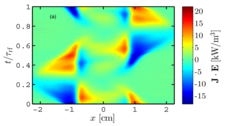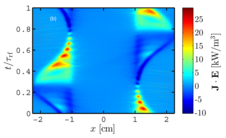Hitun rafeinda í rafneikvæðri rýmdarafhleðslu með flókna efnafræði - verkefni lokið
Fréttatilkynning verkefnisstjóra
Rýmdarafhleðslur sem vinna við lágan gasþrýsting og eru drifnar við útvarpstíðni hafa verið notaðar í efnismeðhöndlun, einkum í framleiðslu smárása, í áratugi. Aflflutningur til rafeinda í rafneikvæðum rýmdarafhleðslum í súrefni og klór var skoðaður með particle-in-cell Monte Carlo hermun.
Í súrefnisrafgasi kemur fram umbreyting frá rek-ambipolar aflflutningi til þrýstingshitunar þegar gasþrýstingur er aukinn (sjá Mynd 1). Slík umbreyting á sér einning stað við fastan þrýsting þegar tíðní er aukin og þegar fjarlægð mill rafskautanna er aukin. Umbreytingin er tengd falli í rafneikvæðni. Þessar niðurstöður byggja á því að byggt var upp tiltölulega nákvæmt líkan af súrefnisafhleðslunni, sem inniheldur einstig hálfstöðugra súrefnissameinda. Klórafhleðsla er alltaf mjög rafneikvæð og rek-ambipolar aflflutningur til rafeinda alltaf ráðandi. Þetta gerir að erfitt að beita óháðri stýringu á jónaflæði og orku jóna á rafskautin. Niðurstöður verkefnisins eru ræddar í nokkrum greinum sem eru listaðar hér að neðan.
English:
The low pressure radio frequency (rf) driven capacitively coupled discharge has been applied for materials processing, in particular in integrated circuit manufacturing, for a few decades. The electron power absorption mechanism in a capacitively coupled discharges in oxygen and chlorine was explored using particle-in-cell Monte Carlo simulations. In the oxygen discharge we observe a transition from drift-ambipolar electron power ansorption to pressure heating as the discharge pressure is increased (see Figure 1). Such transition is also observed when operating at fixed pressure and driving frequence is increased and as the eletrode gap size is increased. This transition we relate to decreaed elctronegativity. These results were achieved by applying a rather detailed model of the oxygen chemistry that included the singlet metastable oxygen molecules. We found the chlorine discharge to be highly electronegative and the drift-ambipolar mode to dominate the electron power absorption. This made it difficult to control independently the ion flux and the ion energy onto the electrodes. The results of the project are discussed in a number of publications listed below.


Figure 1, The spatio-temporal behavior of the electron power absorption for a parallel plate capacitively coupled oxygen discharge with a gap separation of 4.5 cm driven at 13.56 MHz with Vo = 300 V operated at (a) 10 mTorr and (b) 50 mTorr.
[1] H. Hannesdottir and J. T. Gudmundsson, Plasma Sources Science and Technology, 25(5) (2016) 055002
[2] H. Hannesdottir and J. T. Gudmundsson, Journal of Physics D: Applied Physics, 50(17) (2017) 175201
[3] J. T. Gudmundsson and D. I. Snorrason, Journal of Applied Physics, 122(19) (2017) 193302
[4] J. T. Gudmundsson and H. Hannesdottir, AIP Conference Proceedings, 1811 (2017) 120001
[5] J. T. Gudmundsson and A. Hecimovic, Plasma Sources Science and Technology, 26(12) (2017) 123001
[6] J. T. Gudmundsson, D. I. Snorrason and H. Hannesdottir, Plasma Sources Science and Technology, 27(2) (2018) 025009
[7] A. Proto and J. T. Gudmundsson, Plasma Sources Science and Technology, 27(7) (2018) 074002
[8] A. Proto and J. T. Gudmundsson, Atoms, 6(4) (2018) 65
[9] J. T. Gudmundsson and A. Proto, Plasma Sources Science and Technology, 28(4) (2019) 045012
[10] G. A. Skarphedinsson and J. T. Gudmundsson, Plasma Sources Science and Technology, 29(8) (2020) 084004
[11] A. Proto and J. T. Gudmundsson, Journal of Applied Physics, 128(11) (2020) 113302
[12] A. Proto and J. T. Gudmundsson, Plasma Sources Science and Technology, 30(6) (2021) 065009
[13] A. Proto, Electron power absorption in electronegative capacitively coupled discharges, Ph.D. Thesis, University of Iceland, June 2021
Heiti verkefnis:
Hitun rafeinda í rafneikvæðri rýmdarafhleðslu með flókna
efnafræði/Electron heating in electronegative capacitively coupled discharge of
complex chemistry
Verkefnisstjóri: Jón Tómas Guðmundsson, Háskóla Íslands
Tegund styrks: Verkefnisstyrkur
Styrktímabil: 2016-2018
Fjárhæð styrks: 37,498 millj. kr. alls
Tilvísunarnúmer Rannís:
163086


